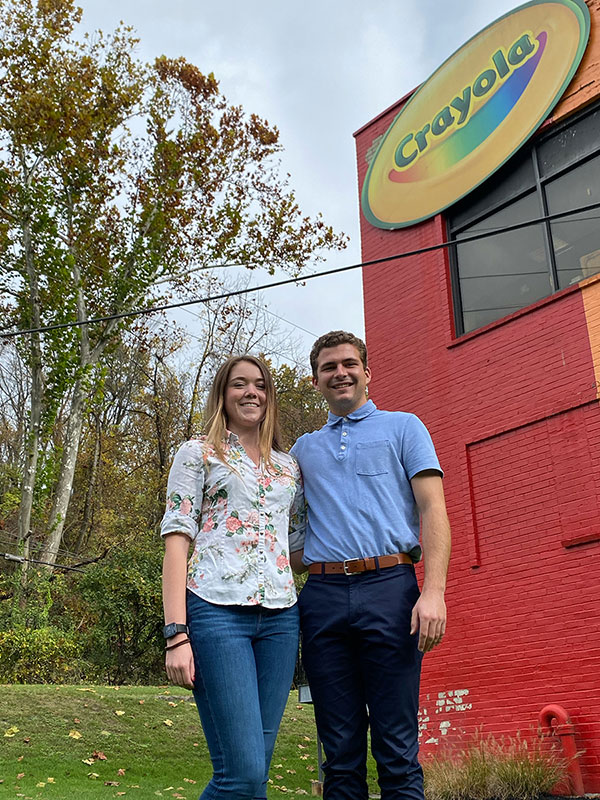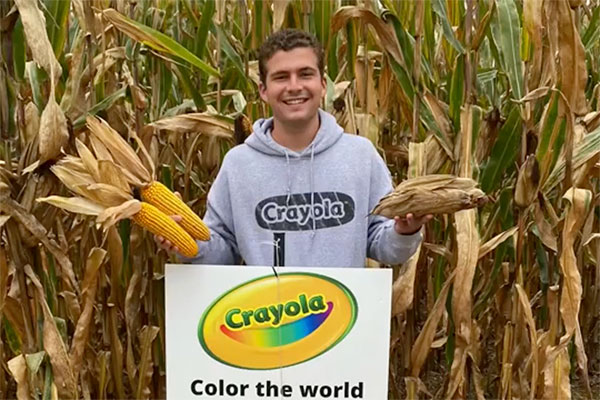As children, it is common to mimic interpretations of “grown up” jobs – doctor, police officer, firefighter. What’s far less common is for a “grown up” job to be closely tied to childlike play. For sophomore Drexel Engineering students Shannon Simcox and Samuel Vaughan, that’s exactly what their co-op experience is allowing them to do.

Shannon Simcox and Samuel Vaughan
Simcox, a chemical engineering student from Williamstown, New Jersey, and Vaughan, a mechanical engineering student from Allentown, Pennsylvania, are working in the research and development department at Crayola, perhaps the nation’s most well-known maker of art supplies.
For Vaughan, who grew up only 20 miles from Crayola’s headquarters in Easton, Pennsylvania, the opportunity represents a dual homecoming.
“Crayola is close to home for me, but it’s also close to the hearts of almost everyone who’s picked up a crayon,” he says. “It’s really rewarding to see the people and the process behind the scenes of such an iconic brand.”
One of Vaughan’s projects is quality assurance for Crayola’s “Colors of the World” markers and crayons. To match skin tones from around the world, Vaughan helps to test the hue, pH and viscosity of the coloring that is added to the products. He says that he’s learned how much engineering goes into each step of the manufacturing process.
“Something I’ve learned is that a lot of what Crayola makes is centered on what they call ‘chemi-mechi-tronics,’” he explains. “Any one of the products we create could have a chemical component, like color-changing ink; a mechanical component, like a sliding bar that makes your drawing dance; or an electronic component, like something that lights up or glows. Every one of those components requires precise engineering.”

Watch: Vaughan is keeping a weekly video blog of his experience on YouTube.
Simcox is working on new product development in physical arts, helping to tweak formulas for clays and putties, among other things. The experience is helping her expand her idea of what she can do with an engineering degree.
“Most chemical engineers that you read about are in the energy sector, or in pharmaceuticals or some other kind of medicine,” Simcox says. “I didn’t consider polymers as an entire job type I could pursue.”
During the co-op, in addition to their work in research and development, Simcox and Vaughan have gotten to volunteer in Crayola’s manufacturing building. Simcox says that the opportunity to see the full scope of their work is unique.
“We knew that we’d be working on the beginnings of projects,” she says. “The research, the creation. But because we were given a chance to visit the manufacturing sites, we get to see how everything is actually made and how packaging is done. You get a better sense of the entire process.”
The co-op is also teaching the pair valuable skills that they’ll bring back to the classroom with them.
“When you start a co-op at Crayola, they treat you like any other employee,” Simcox says. “That means you need to learn how to manage time. You need to develop good communications skills with coworkers, with your supervisors and in meetings. And you need to work as a team to solve problems. All those skills are going to be important in our interactions with professors, classmates, and on team projects.”